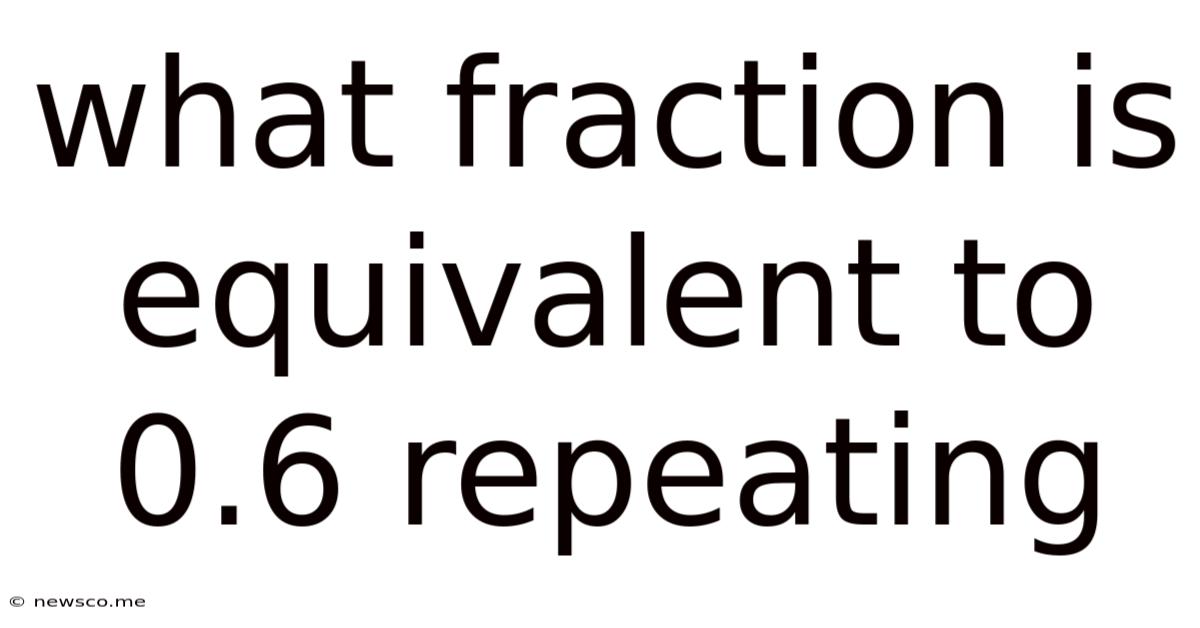What Fraction Is Equivalent To 0.6 Repeating
News Co
Mar 28, 2025 · 5 min read

Table of Contents
What Fraction is Equivalent to 0.6 Repeating? A Deep Dive into Decimal-to-Fraction Conversion
The seemingly simple question, "What fraction is equivalent to 0.6 repeating?" opens a door to a fascinating exploration of decimal representation and fraction conversion. While the answer itself is straightforward, understanding the why behind the conversion unlocks a deeper understanding of mathematical principles and provides valuable skills applicable in various fields. This comprehensive guide will delve into the intricacies of converting repeating decimals to fractions, focusing specifically on 0.6 repeating (denoted as 0.6̅ or 0.666...). We'll explore multiple methods, illustrating each step with clear explanations and examples. By the end, you'll not only know the answer but also understand the underlying mechanics, empowering you to tackle similar problems with confidence.
Understanding Repeating Decimals
Before diving into the conversion process, let's clarify the concept of repeating decimals. A repeating decimal is a decimal number where one or more digits repeat infinitely. We denote this repetition using a bar over the repeating digits. For instance:
- 0.333... is written as 0.3̅
- 0.142857142857... is written as 0.142857̅
- 0.666... is written as 0.6̅
This notation is crucial because it concisely represents an infinitely long decimal. Without this notation, we could only approximate the value. Understanding this notation is the first step to successfully converting repeating decimals into fractions.
Method 1: Algebraic Manipulation
This is arguably the most common and widely understood method for converting repeating decimals to fractions. Let's apply it to 0.6̅:
-
Assign a Variable: Let 'x' represent the repeating decimal:
x = 0.6̅ -
Multiply to Shift the Decimal: Multiply both sides of the equation by a power of 10 that shifts the repeating part to the left of the decimal point. Since only one digit repeats, we multiply by 10:
10x = 6.6̅ -
Subtract the Original Equation: Subtract the original equation (
x = 0.6̅) from the multiplied equation (10x = 6.6̅). This crucial step eliminates the repeating part:10x - x = 6.6̅ - 0.6̅9x = 6 -
Solve for x: Divide both sides by 9 to isolate 'x':
x = 6/9 -
Simplify the Fraction: Simplify the fraction to its lowest terms by dividing both the numerator and denominator by their greatest common divisor (GCD), which is 3:
x = 2/3
Therefore, the fraction equivalent to 0.6̅ is 2/3.
Method 2: Geometric Series Approach
This method leverages the concept of an infinite geometric series. A geometric series is a sequence where each term is found by multiplying the previous term by a constant value (the common ratio). An infinite geometric series converges to a finite sum if the absolute value of the common ratio is less than 1.
Let's represent 0.6̅ as a sum of an infinite geometric series:
0.6̅ = 0.6 + 0.06 + 0.006 + 0.0006 + ...
This is a geometric series with:
- First term (a): 0.6
- Common ratio (r): 0.1
The formula for the sum of an infinite geometric series is: S = a / (1 - r), where |r| < 1.
Substituting our values:
S = 0.6 / (1 - 0.1) = 0.6 / 0.9 = 6/9 = 2/3
Again, we arrive at the fraction 2/3. This method demonstrates the connection between repeating decimals and the elegant concept of infinite geometric series.
Method 3: Using a Fraction Calculator (for verification)
While not a method for deriving the fraction from scratch, using a fraction calculator can serve as a valuable verification tool. Many online calculators and apps are available that can convert repeating decimals to fractions. Inputting 0.6̅ (or a sufficient approximation like 0.666666) into such a calculator will confirm the result as 2/3. This approach is particularly useful for checking your work after using the algebraic or geometric series methods.
Expanding the Concept: Converting Other Repeating Decimals
The methods described above are not limited to 0.6̅. They can be applied to any repeating decimal. Let's illustrate with a more complex example: 0.142857̅
-
Assign a variable:
x = 0.142857̅ -
Multiply to shift: Since six digits repeat, we multiply by 10⁶ (1,000,000):
1,000,000x = 142857.142857̅ -
Subtract:
1,000,000x - x = 142857.142857̅ - 0.142857̅This simplifies to999,999x = 142857 -
Solve for x:
x = 142857 / 999,999 -
Simplify: The simplified fraction is 1/7.
This example showcases how the process adapts to decimals with longer repeating sequences. The key is always to multiply by the appropriate power of 10 to align the repeating part for subtraction.
The Significance of Understanding Decimal-to-Fraction Conversion
The ability to convert repeating decimals to fractions is more than just a mathematical exercise. It has practical applications in various fields:
- Engineering and Physics: Accurate calculations often require fractional representations for precise measurements and calculations.
- Computer Science: Understanding decimal representation is fundamental in working with numerical data types and algorithms.
- Finance: Accurate calculations are vital in financial modeling and transactions, where even small errors can have significant consequences.
- Mathematics itself: It is an essential concept in number theory, analysis, and other advanced mathematical fields.
Conclusion
Converting the repeating decimal 0.6̅ to its equivalent fraction, 2/3, provides a gateway to understanding fundamental mathematical concepts. Through algebraic manipulation, the geometric series approach, or verification with a fraction calculator, we can confidently arrive at the correct answer. Furthermore, understanding these conversion methods equips you to handle more complex repeating decimals, fostering a deeper appreciation for the interconnectedness of different mathematical representations. This skill, seemingly simple, holds significant value in various disciplines and contributes to a more robust understanding of the numerical world.
Latest Posts
Related Post
Thank you for visiting our website which covers about What Fraction Is Equivalent To 0.6 Repeating . We hope the information provided has been useful to you. Feel free to contact us if you have any questions or need further assistance. See you next time and don't miss to bookmark.